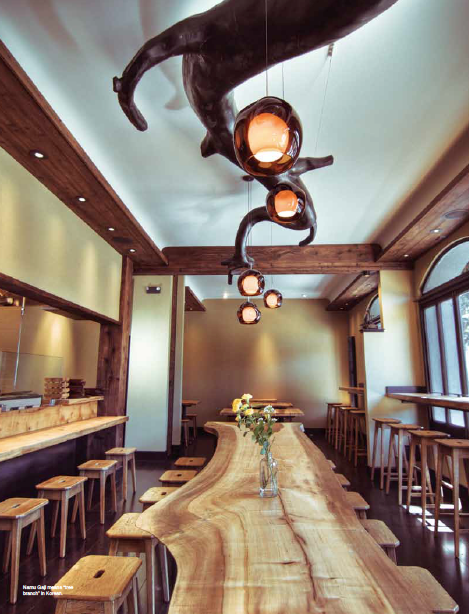DEPT The Good Life
ISSUE Fall 2012
AUTHOR Kanara Ty
PHOTOS Interior photo by Mohammad Gorjestani, all other photos by Jennifer Yin.
In recent years, the San Francisco Bay Area’s culinary scene has grown beyond the local-produce-loving-community it has become recognized for. In fact, it is steadfastly becoming the playground for renowned chefs to create some of the region’s most creative and innovative dishes. Of course, this all comes at a hefty price – many folks will find themselves breaking the bank to eat at some of the Bay Area’s most coveted restaurants. While this may be an exciting time for food enthusiasts, the accessibility to such experiences is another matter.
Enter Executive Chef Dennis Lee of Namu Gaji. For Lee, community is family. It’s one of the reasons why Lee chooses to make his kitchen more accessible: to make his customers feel like they’re at home.
Trained by both his mother and famed chef Ming Tsai of Blue Ginger, Lee, along with his brothers, David and Daniel, began their foray into the culinary landscape with their first venture, Namu, in 2006. Nestled in San Francisco’s quaint Richmond District, the restaurant garnered a loyal group of fans in both locals and culinary professionals alike thanks to of their distinctive spin on everyday dishes like ramen, Korean fried chicken and their Real Korean Taco. Much to everyone’s
surprise, Namu closed shop on Christmas Eve 2011, only to also announce that they would begin the second leg of their journey at Namu Gaji. The following April, Namu Gaji opened its doors in San Francisco’s Mission District.

For Lee, it was all about location. “The community here [in the Mission District] is younger and more eclectic. There’s a broader range of diners,” says Lee. “Being here gives us an opportunity to do more things more successfully than we would in the old location.”
The community has embraced Namu Gaji, and its family extends local vendors like farmers, breweries and wineries. Farmer Kristyn Leach works exclusively with Namu Gaji and grows Korean chiles and herbs not readily available in the States. Namu Gaji’s wine director, Collin Casey, works with local producers to create the perfect menu of beverages, including a signature beer from Magnolia Brewery’s Dave McLean.
“When I go into a restaurant, I don’t want something that’s cookie cutter or generic,”
says Lee. “I want to be able to experience and taste the flavors that come from an individual
or a team of people.”
Even the restaurant’s interior draws from a local landmark: the bar in the restaurant was made from a Cypress tree salvaged from Golden Gate Park (Namu Gaji means “tree branch” in Korean). Lee worked with interior designer Brian Ford of Metropolis Design and woodworker Jeff Burwell of Burwell
Arts to create an atmosphere that’s warm and inviting in a traditional Korean style.
Though much of Lee’s culinary training comes from the Korean women in his family
(grandmother, mother and aunt), the taste he has created is all his own – a hodgepodge
of flavors and ingredients that he favors. “Generally speaking, we’re inclined to a more dynamic flavor set,” says Lee. “We use a lot of acid and we like to bring our umami richness, but not in a very straight-up way. I think our dumplings are a good example of that – they’re very intense and rich, using mainly [shitake] mushrooms, as well as traditional ingredients like dashi. Our orange wine, which is unpasteurized, is a very fresh wine, not aged at all. It goes with that type of bold cuisine.”
While some fan favorites from Lee’s first venture, Namu, have found their way onto
Namu Gaji’s menu, Lee is always experimenting and growing the menu. “In the old place, we would have to do something more traditional, like a pork chop with our own twist to it,” says Lee. “Here we’re able to do two to three different treatments of a pig, in different parts and all on one plate.”
There’s already a standout dish: the beef tongue. Lee’s aunt played an important part in directing the restaurant’s fermentation program, bringing over strains of bacteria from the family’s South Korean village, which has an impact on the beef tongue’s signature taste. “We do a lot of pickling here,” says Lee. “The beef tongue goes through this long process: it’s brined overnight, braised, then it’s pickled for a week and lastly, it’s grilled to order. You get that bright flavor from pickling, the richness because it’s beef tongue, and then the nice, grilled charred flavor on the outside.
“For me, it’s difficult to keep staple menu items because I feel cooking should be more natural,” he adds. “Things don’t need to taste the same every time you come in, as long as it tastes good.”







